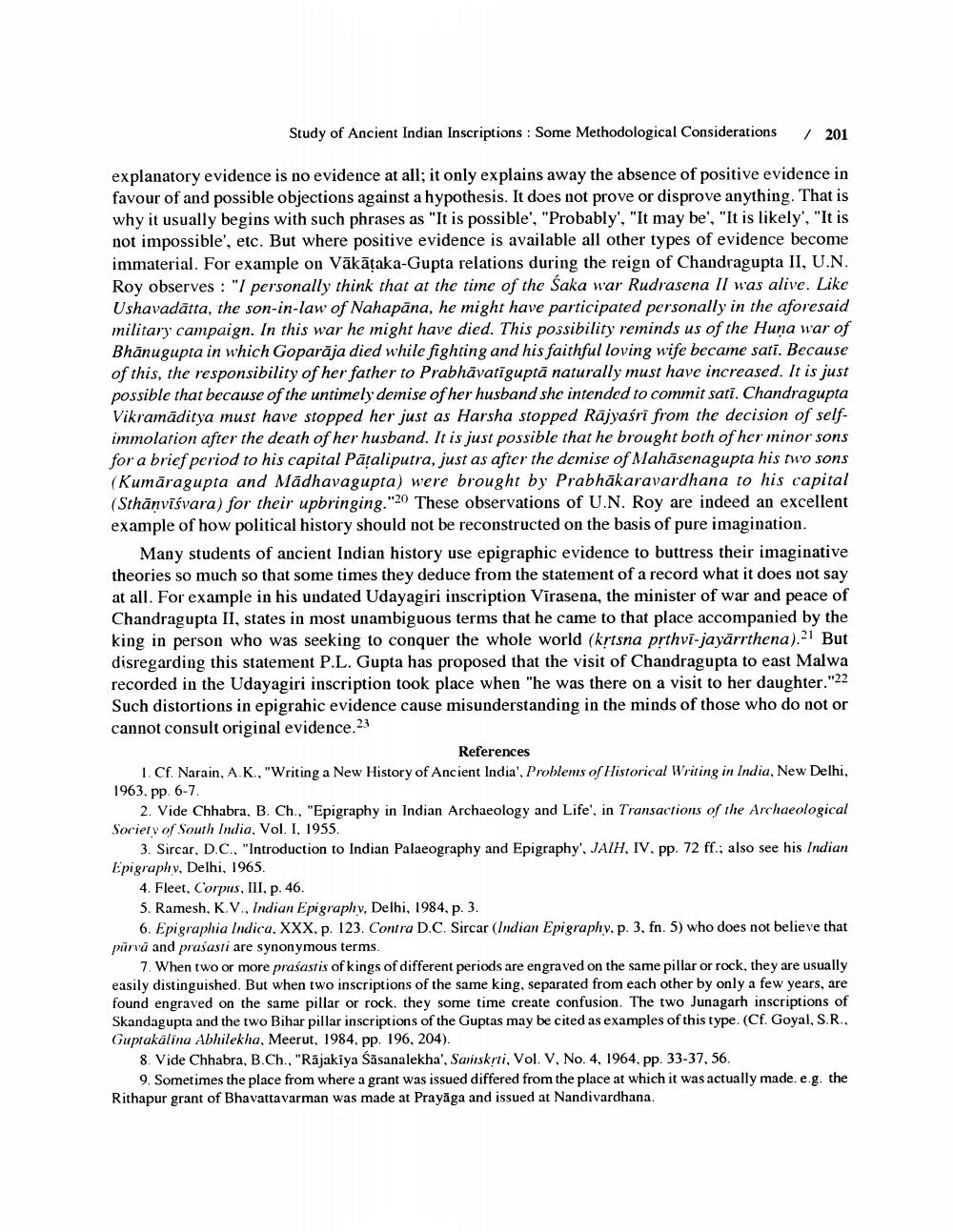________________
Study of Ancient Indian Inscriptions : Some Methodological Considerations
/ 201
explanatory evidence is no evidence at all; it only explains away the absence of positive evidence in favour of and possible objections against a hypothesis. It does not prove or disprove anything. That is why it usually begins with such phrases as "It is possible', "Probably', "It may be', "It is likely', "It is not impossible', etc. But where positive evidence is available all other types of evidence become immaterial. For example on Vākāțaka-Gupta relations during the reign of Chandragupta II, U.N. Roy observes : "I personally think that at the time of the Saka war Rudrasena II was alive. Like Ushavadātta, the son-in-law of Nahapāna, he might have participated personally in the aforesaid military campaign. In this war he might have died. This possibility reminds us of the Huna war of Bhānugupta in which Goparāja died while fighting and his faithful loving wife became sati. Because of this, the responsibility of her father to Prabhāvatiguptā naturally must have increased. It is just possible that because of the untimely demise of her husband she intended to commit sati. Chandragupta Vikramāditya must have stopped her just as Harsha stopped Rajyasri from the decision of selfimmolation after the death of her husband. It is just possible that he brought both of her minor sons for a brief period to his capital Pataliputra, just as after the demise of Mahasenagupta his two sons (Kumāragupta and Madhavagupta) were brought by Prabhākaravardhana to his capital (Sthānvīśvara) for their upbringing."20 These observations of U.N. Roy are indeed an excellent example of how political history should not be reconstructed on the basis of pure imagination.
Many students of ancient Indian history use epigraphic evidence to buttress their imaginative theories so much so that some times they deduce from the statement of a record what it does not say at all. For example in his undated Udayagiri inscription Virasena, the minister of war and peace of Chandragupta II, states in most unambiguous terms that he came to that place accompanied by the king in person who was seeking to conquer the whole world (krtsna prthvi-jayārrthena).21 But disregarding this statement P.L. Gupta has proposed that the visit of Chandragupta to east Malwa recorded in the Udayagiri inscription took place when "he was there on a visit to her daughter."22 Such distortions in epigrahic evidence cause misunderstanding in the minds of those who do not or cannot consult original evidence.23
References 1. Cf. Narain, A.K, "Writing a New History of Ancient India', Problems of Historical Writing in India, New Delhi, 1963. pp. 6-7
2. Vide Chhabra, B. Ch., "Epigraphy in Indian Archaeology and Life', in Transactions of the Archaeological Society of South India, Vol. I, 1955
3. Sircar, D.C., "Introduction to Indian Palaeography and Epigraphy', JAIH, IV. pp. 72 ff.; also see his Indian Epigraphy, Delhi, 1965.
4. Fleet, Corpus, III, p. 46. 5. Ramesh, K.V.. Indian Epigraphy, Delhi, 1984, p. 3.
6. Epigraphia Indica, XXX. p. 123. Contra D.C. Sircar (Indian Epigraphy. p. 3. fn. 5) who does not believe that purvā and prasasti are synonymous terms.
7. When two or more praśastis of kings of different periods are engraved on the same pillar or rock, they are usually easily distinguished. But when two inscriptions of the same king, separated from each other by only a few years, are found engraved on the same pillar or rock, they some time create confusion. The two Junagarh inscriptions of Skandagupta and the two Bihar pillar inscriptions of the Guptas may be cited as examples of this type. (Cf. Goyal, S.R., Guptakalina Abhilekha, Meerut, 1984, pp. 196, 204).
8. Vide Chhabra, B.Ch, "Räjakiya Sasanalekha', Sarirskri, Vol. V. No. 4, 1964, pp. 33-37, 56.
9. Sometimes the place from where a grant was issued differed from the place at which it was actually made. e.g. the Rithapur grant of Bhavattavarman was made at Prayāga and issued at Nandivardhana.




